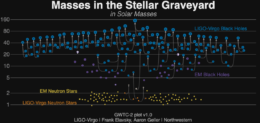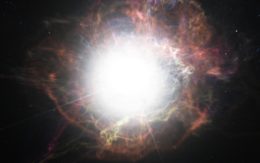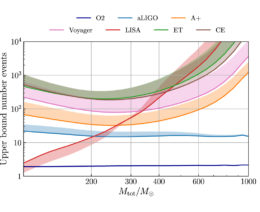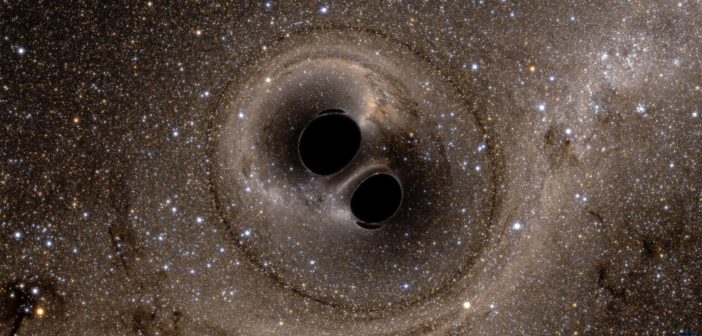Theory predicts that gravitational-wave detectors should be able to observe a population of huge black holes. A new study explores what we’ll learn from these mysterious objects and when we can hope to find them.
A Preferred Size

A recent version of the rapidly expanding “stellar graveyard”, a plot that shows the masses of the different components of observed compact binary mergers. Click to enlarge. [LIGO-Virgo/Northwestern U./Frank Elavsky & Aaron Geller]
The LIGO/Virgo gravitational-wave detectors have discovered signals from dozens of black-hole binaries completing their final death spirals and merging. So far, these observed primary black holes have primarily fallen into a mass range below ~45 solar masses, indicating a precipitous drop in the population of binary black holes above this mass.

Artist’s impression of a supernova. Progenitor stars of a certain mass are susceptible to pair-instability supernova, preventing the formation of a black hole. [ESO/M. Kornmesser]
Avoiding an Unstable End
Why the dearth of heavier black holes? Theorists have an explanation: the pair-instability supernova mass gap. Based on our understanding of stellar evolution, black holes in a certain mass range — roughly 50–120 solar masses — shouldn’t be able to form. This mass gap arises because the progenitor stars needed to produce black holes of this size are predicted to undergo a runaway process, eventually exploding as violent supernovae that prevent remnant black holes from forming.
The formation of black holes above ~120 solar masses, however, should still be possible — so we’d expect a population of enormous far-side-of-the-mass-gap black holes to be lurking in our galaxy and beyond. In a new study, University of Chicago scientists Jose María Ezquiaga and Daniel Holz dig further into this prediction.
Hunt on the Far Side
Ezquiaga and Holz use the statistics of past black-hole binary detections and predictions of the capabilities of current and future gravitational-wave detectors to estimate what’s in store for us in terms of far-side black holes.
First, the authors show that these heavyweights would be the most massive sources detectable by LIGO/Virgo, and — if they exist — we should be able to spot up to tens of them during LIGO/Virgo’s next two observing runs (O4 and O5).

The estimated maximum number of black-hole-binary mergers detected per year for various current and upcoming ground-based gravitational-wave detectors, and in 4 years for LISA. [Adapted from Ezquiaga & Holz 2021]
Finally, Ezquiaga and Holz show that observations of far-side binaries with LISA, LIGO/Virgo, and the Einstein Telescope (a next-generation detector) will provide an independent measure of the expansion of the universe at different redshifts: z ~ 0.4, 0.8, and 1.5, respectively. By exploiting the upper edge of the mass gap, far-side black holes can act as standard sirens and enable precision cosmology.
Soon To Be Found?
So what’s the upshot? The outlook is good for far-side black holes!
If these heavyweights exist, we should spot them within the next couple years and they’ll be able to provide us with valuable insight into a variety of science questions. If we don’t observe any within this time frame, that also provides a powerful statement about black-hole formation, demanding new theories to explain the dearth.
Citation
“Jumping the Gap: Searching for LIGO’s Biggest Black Holes,” Jose María Ezquiaga and Daniel E. Holz 2021 ApJL 909 L23. doi:10.3847/2041-8213/abe638


8 Comments
Pingback: From AAS NOVA : “Jumping the Gap to Probe Large Black Holes” | sciencesprings
Pingback: Przeskakiwanie luki masowej w celu zbadania dużych czarnych dziur – PTMA Kraków
Pingback: Przeskakiwanie luki masowej w celu zbadania dużych czarnych dziur – Astronomia Śląska
Pingback: Jumping the Gap to Probe Large Black Holes - Sky & Telescope - Night Vision Now
Pingback: Black Holes Avoid Forming in Certain Sizes | CosmoQuest
Pingback: Supernovae and Galaxies Being Used to Solve Astrophysics’ Biggest Questions | The Daily Space
Pingback: Jumping the Gap to Probe Large Black Holes – Sky & Telescope - News 100
Pingback: New Insights from LIGO/Virgo’s Merging Black Holes